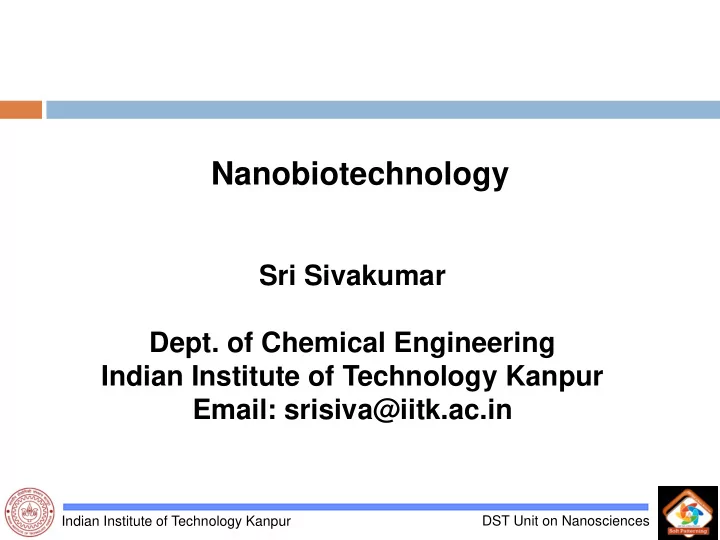

Nanobiotechnology Sri Sivakumar Dept. of Chemical Engineering Indian Institute of Technology Kanpur Email: srisiva@iitk.ac.in Indian Institute of Technology Kanpur DST Unit on Nanosciences
How old is it? (Lycurgus Cup) Transmission Reflection Indian Institute of Technology Kanpur DST Unit on Nanosciences
Faraday’s gold sol 20–40 nm in diameter gold nanoparticles Indian Institute of Technology Kanpur DST Unit on Nanosciences
“Nano” A Magic Word!! CdSe nanoparticles Same material but emits different colours!!! Indian Institute of Technology Kanpur DST Unit on Nanosciences
Nanomaterials vs Bulk materials How many number of 1 nm cubes can be carved m out of 1 m cubes and calculate the surface area? Number of nanocubes = 1 m 3 / 1x 10 -27 m 3 = 1x 10 27 Surface area = (1 x 10 27 ) x (6 x 10 -18 m 2 ) = 6 x 10 9 m 2 = 6000 Km 2 SA = 6 m 2 The total area of the nanocubes is a billion times that of the 1 m cube. Approximately Equal to the area of 1/7th of Haryana state (44000 Km 2 ). Lesson: Surface area is inversely proportional to size of the particle of the same volume Why surface area is important? It decides many physical properties of material The power of nano Indian Institute of Technology Kanpur DST Unit on Nanosciences
How to minimize surface energy? Citrate ligand Indian Institute of Technology Kanpur DST Unit on Nanosciences
“Nano” A Magic Word!! Nature of electron in nanostructure (Wave like) is different from microstructure (particle like) • Quantum s siz ize c confinement • Wave-like like t transpo nsport rt • Domin inant ant i interfac erfacial ial phenomena Electr trical, ical, o optica ical, l, t thermal, rmal, magnetic, netic, c chemical, emical, mechan anical, ical, a and biological ological p properties operties ? ?? Indian Institute of Technology Kanpur DST Unit on Nanosciences
How to make nanomaterials as smart materials? What are smart materials? • Materials senses a stimulus (eyes). - pH, temperature, enzyme, antigen, light, etc. • Takes an intelligent decision (brain). • Should remain silent in the absence of stimuli Why do we need smart materials? After Befor chemo chem Indian Institute of Technology Kanpur DST Unit on Nanosciences
Smart materials – Biomedical Applications Stimuli Internal Stimuli (inside our body) External Stimuli - pH - Light - Temperature (healthy cells – 37 o C - Ultrasonics cancerous cell - 40 o C) - Magnetic - Glucose concentration (Diabetic patients) - Enzyme (Glutathione in lysosome) How to make them act smart? Indian Institute of Technology Kanpur DST Unit on Nanosciences
Smart materials Drug delivery Bioimaging NIR sensors Biosensors Indian Institute of Technology Kanpur DST Unit on Nanosciences
Smart materials Broad classification of materials - Polymers (capsules, Micells, nanoparticles) - Inorganic materials (Gold, Iron, Semiconductor Nps) - Biomaterials (Proteins, DNAs) - Carbon-based materials (CNTs, C 60 , graphene,) Indian Institute of Technology Kanpur DST Unit on Nanosciences
Quantum Dots vs Organic Dyes Organic dye Quantum dot Organic dye Quantum dot Lesser photobleaching – Better Imaging Indian Institute of Technology Kanpur DST Unit on Nanosciences
Targeted Nanoparticles Indian Institute of Technology Kanpur DST Unit on Nanosciences
Multifunctional nanomaterials Indian Institute of Technology Kanpur DST Unit on Nanosciences
Synthesis of nanomaterials Top-down approach e.g. Ball milling, Extrusion, Lithography, Etching Bottom-up approach e.g. Colloidal synthesis, Chemical vapour deposition, Combustion and etc.
Au nanoparticles: How to prepare? Turkevich Method (Reduction of Gold ion by citrate ions) + ~ 15-20 nm ( Color My Nanoworld by Adam D. McFarland, Christy L. Haynes, Chad A. Mirkin, Richard P. Van Duyne, and Hilary A. Godwin*, J. Chem. Educ. 2004 , 81 , 544 A. Undergraduate Lab experiments
Silica particles Stober’s synthesis NH 4 OH, Ethanol, H 2 O Tetraethyl orthosilicate Silica particles Undergraduate Lab experiments Characterization techniques – UV vis absorption, scanning electron microscope (table top), Fluorescence spectroscopy, FTIR, XRD, etc
Bottom-up approach Aqueous medium synthesis Thiol ligands R-SH Cd(ClO 4 ) 2 + H 2 S/Se/Te CdX (X = S, Se, Te) 95 0 C Control of growth: • Concentration of ligand, reactants • pH • Temperature and duration of heating • 15-20% broad distribution
Summary Interdisciplinary – Nanoscience and Biology Biology students should learn about nanomaterial aspects – basic concepts Materials background students should learn about biology aspects Reading materials can be collected from text books, and journals Undergraduate Lab experiments
Recommend
More recommend